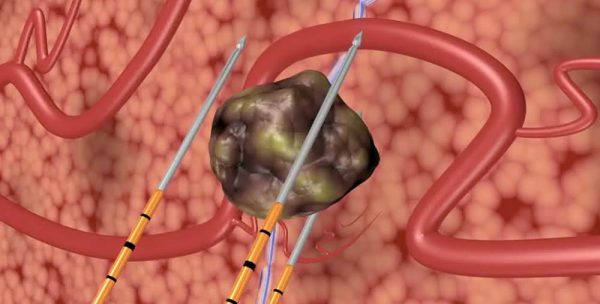Focal Therapy
Home » Prostate Cancer » Treatment of prostate cancer » Focal Therapy
Focal therapy for prostate cancer
The classic prostate cancer treatment (PCa) has been, until not too long ago, the complete prostate removal surgery or radical prostatectomy (RP), and radiotherapy (RT). This is due to the fact that transrectal randomised prostate biopsies did not allow real mapping of the prostate tumour affection.
This has led to two important situations. First, the inability to reliably detect those patients with non-aggressive tumours which, if left to their natural progression, would not put their lives at risk, and instead of being treated only required monitoring. Secondly, as mapping of tumour affectation was not available, it was not possible to offer the possibility of carrying out focal therapies that could avoid more aggressive surgeries and with frequent sequela.
Today, thanks to the excellent information provided by fusion biopsies, we can evaluate exactly the extent of the tumour inside the prostate, as well as its aggressiveness. This allows treating only these index lesions. These are the most important tumour lesions, which finally determine the prognosis for the disease. This is known as focal therapy.
Focal therapy allows treating only the tumour area. This procedure seems to provide the same oncologic results, but with minimal functional consequences in comparison with surgery and radiotherapy, which can lead to erectile dysfunction, urinary incontinence, and other less frequent complications, such as urinary fistulas and urethral stenosis, which may seriously deteriorate the patient’s quality of life.
Focal therapy advantages
- Minimally invasive treatment.
- Minimal side effects in terms of urination and erectile function. It may even improve voiding quality in some patients.
- Minimal risk of bleeding.
- Frequently, outpatient treatment or short-term hospital stay.
- The short recovery time allows for a quick return to everyday life.
- Mild or moderate transient pain, easily managed with analgesics.
- There is no need for other secondary treatments (RT, Chemotherapy)

In our Prostate Cancer Unit we have three sources of energy for focal therapy treatments: Cryotherapy, HIFU and Electroporation.
Each patient is subject to personalized planning and will receive the source that best suits her needs, depending on the characteristics of the tumor and the individual himself.
Cryotherapy uses very low temperatures to destroy cancer cells. The desired area of the prostate is frozen and all the tumour tissue destroyed thanks to needles placed transperineally in the areas to be treated.
This technique is used all over the world and has a clinical track record that confirms its safety and effectiveness.
It is the acronym for high-intensity focused ultrasound. It achieves the same harmful effect over the tumour areas, this time thanks to the heat concentrated by the ultrasound device over the desired area. Applied only transrectally, without the need to puncture the transperineal area. In a short period of time, the temperature increases to at least 90° at the focal point, destroying it without affecting other adjacent tissues.
Electroporation also enables preserving, as much as possible, the healthy structures surrounding the tumour lesion to be treated.
Several needles are placed transperineally to create a voltage between them. Thus, a series of short, high-voltage electrical pulses are administered, which have a selective destructive effect on the cancer cells of the lesion to be treated.
